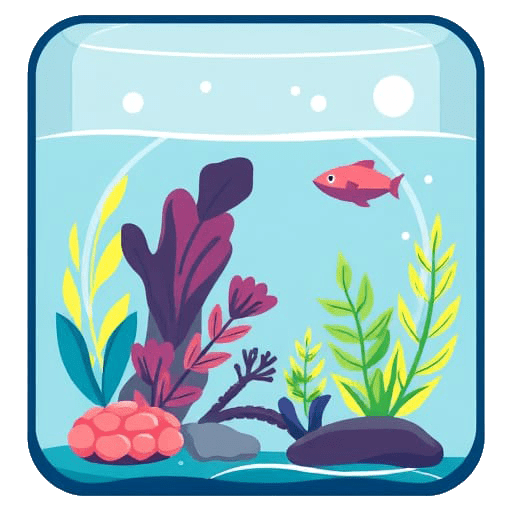Ember Tetras are beautiful red/orange freshwater fish that can be kept as a pet. They are perfect choices for nano fish tanks due to their small size. They’re peaceful schooling fish that greatly add to most community aquariums. This fish species is excellent if you’re looking to fill your aquarium with tiny fish. This guide will cover Ember Tetra care. It will discuss this specie’s aquarium requirements, food & diet, compatible tank mates, and breeding habits.
Aquarium Requirements
Ember Tetras are very peaceful fish that stay very small. They will be about an inch in length when fully grown. This makes them excellent candidates for nano aquariums as a centerpiece schooling fish or a schooling fish that blends into the background of a large aquarium. A well-planted aquarium with various rocks and driftwood makes the perfect enclosure for Ember Tetras.
How Many Ember Tetras in a 10 Gallon Tank?
A minimum of 6 fish are recommended to be considered a school. You should be able to successfully keep between 10 to 15 Ember Tetras in a 10-gallon fish tank. The max size of Ember Tetras and their incredibly small bio load gives you some flexibility regarding population sizes in a fish tank.
Water Parameters
Learning the water parameters for your aquarium is important to its success. Fish like the Ember Tetra are found in the tropical waterways of South America. This type of water is much different than what can be found in Lake Tanganyika, which has much harder and calcium-rich water. The following are water parameter ranges that will help you successfully keep Ember Tetras.
- Temperature: 72° – 77°F
- pH: 5.5 – 7.0
- Water Hardness: 4 – 8 KH
Based on the water parameters you can see that Ember Tetras do best in softer and acidic water. Some homes have naturally soft and acidic water, but there are many homes such as ones with wells that do not. Often well water is rich in calcium and other minerals that cause a spike in pH levels and hardness. An easy way to test for this is through the use of an aquarium test kit. I recommend purchasing an API Freshwater Master Test Kit and API GH & KH test kit. With these test kits, you can keep an eye on your aquarium’s pH, General Hardness (GH), Carbonate Hardness (KH), ammonia, nitrites, and nitrates.
Food & Diet
Ember Tetras stay incredibly small, they may not be able to consume the large fish food that is often provided. They will do great with frozen daphnia, brine shrimp, and Mysis Shrimp. Traditional pellet food may be a little large for them to consume, so I recommend feeding them Ultra Fresh Tropical Micro Pellets and flake food such as New Life Spectrum All Purpose Flake Food. In the wild Ember Tetras eat a variety of foods so it is important to provide the same experiences in the aquarium.
Tank Mates
Ember Tetras, like most peaceful fish, will do fantastic with most other peaceful community fish. Keeping them with Tetras, Rasboras, Corycats, Honey Gouramis, Endlers Livebearers, Guppies, and other community species, should be successful.
Due to their size, I would not recommend keeping Ember Tetras with large fish, fish with large mouths, and fin nippers. Their small size and peaceful temperament do not allow them to hold their own against more aggressive fish. You will want to keep them with community fish that will not harass Ember Tetras.
Breeding
A large enough school will provide you with both males and females. In a well-established and healthy aquarium, Ember Tetras should breed on their own without much intervention. However, getting eggs to hatch before getting eaten and having your fry develop into adulthood will be the challenge.
Ember Tetras scatter their eggs throughout the aquarium after spawning. The eggs are adhesive and will stick to many different surfaces in the fish tank. To provide the best chance for the eggs, a heavily planted aquarium will be needed to provide hiding places for the eggs to adhere to. I recommend many different plant species, especially things like java moss that grow dense which may create cover for eggs. A lot of plants will also benefit from providing cover for the fry once they hatch.
Eggs and fry are likely to get eaten by most other inhabitants of the aquarium. Keeping your Ember Tetras in a species-only aquarium will help cut down on the die-off. For more information on breeding, check out real life experiences of breeding Ember Tetras on Fishforums.
Final Notes
If you enjoy nano fish tanks and micro fish, Ember Tetras might be an excellent choice for you. They are small, stay small, have a nearly non-existent bio-load, and generally are great fish to keep. Their red/orange colorations will pop in a well-planted aquarium and maybe just the final touch you need for your fish tank. If you’re not sold on Ember Tetras, consider checking out other Red Tropical Fish for your Freshwater Fish Tank.

